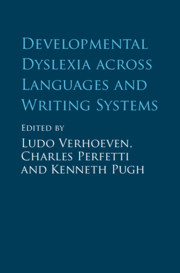Book contents
- Developmental Dyslexia across Languages and Writing Systems
- Developmental Dyslexia across Languages and Writing Systems
- Copyright page
- Contents
- Figures
- Tables
- Contributors
- 1 Introduction
- Part I Developmental Dyslexia across Languages and Writing Systems
- 2 Developmental Dyslexia in English
- 3 Developmental Dyslexia in French
- 4 Developmental Dyslexia in Dutch
- 5 Developmental Dyslexia in Czech and Slovak
- 6 Developmental Dyslexia in Finnish
- 7 Developmental Dyslexia in Russian
- 8 Developmental Dyslexia in Hebrew
- 9 Developmental Dyslexia in Japanese
- 10 Developmental Dyslexia in Chinese
- Part II Cross-Linguistic Perspectives on Developmental Dyslexia
- Epilogue
- Index
- References
10 - Developmental Dyslexia in Chinese
from Part I - Developmental Dyslexia across Languages and Writing Systems
Published online by Cambridge University Press: 27 September 2019
- Developmental Dyslexia across Languages and Writing Systems
- Developmental Dyslexia across Languages and Writing Systems
- Copyright page
- Contents
- Figures
- Tables
- Contributors
- 1 Introduction
- Part I Developmental Dyslexia across Languages and Writing Systems
- 2 Developmental Dyslexia in English
- 3 Developmental Dyslexia in French
- 4 Developmental Dyslexia in Dutch
- 5 Developmental Dyslexia in Czech and Slovak
- 6 Developmental Dyslexia in Finnish
- 7 Developmental Dyslexia in Russian
- 8 Developmental Dyslexia in Hebrew
- 9 Developmental Dyslexia in Japanese
- 10 Developmental Dyslexia in Chinese
- Part II Cross-Linguistic Perspectives on Developmental Dyslexia
- Epilogue
- Index
- References
Summary
Developmental dyslexia is characterized by unexpectedly low reading ability in people who have adequate nonverbal intelligence, have acquired typical schooling, and have experienced sufficient sociocultural opportunities (Gabrieli, 2009; Peterson & Pennington, 2012). It is a recognized disorder in many literate societies and has been studied in a large variety of languages (Caravolas, 2005). The Chinese writing system presents sharp contrast to the alphabetic writing system in terms of how the graphic unit maps onto phonology and semantics. Thus, the investigations into the mechanisms for Chinese reading disability are important to the understanding of the universal and language-specific mechanisms of developmental dyslexia. The behavioral and neural correlates of Chinese developmental dyslexia have been studied extensively in the past twenty years or so, providing us with a rich understanding of Chinese developmental dyslexia.
- Type
- Chapter
- Information
- Developmental Dyslexia across Languages and Writing Systems , pp. 200 - 226Publisher: Cambridge University PressPrint publication year: 2019
References
- 7
- Cited by



